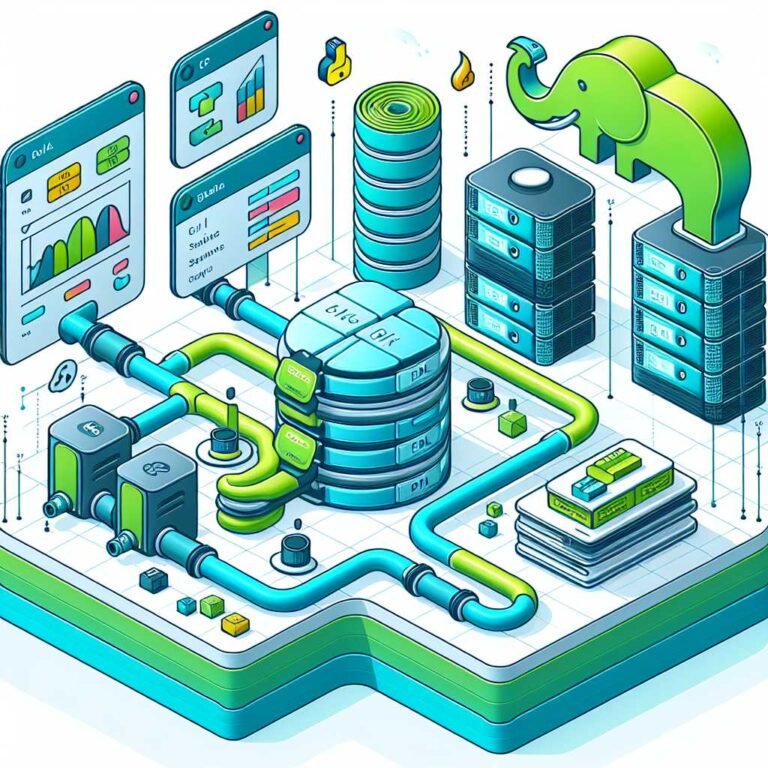Data Engineering with Python and SQL: Build ETL Pipelines, Use Big Data Tools, and Ship Real‑World Analytics Projects
What if you could turn chaotic logs, CSVs, and streams into clean, query-ready data that powers dashboards, machine learning, and real business decisions? That’s the promise of modern data engineering—and it’s more accessible than you might think.
If you’re ready to build real ETL pipelines, wrangle big data with confidence, and ship analytics projects that leaders actually use, this guide will walk you through the tools, patterns, and decisions that matter. We’ll focus on Python and SQL (the industry’s workhorse duo), introduce the modern data stack, and then build up to real projects you can put on your portfolio.
Data Engineering, Explained in Plain English
Data engineering is the discipline of moving and shaping data so it’s accurate, timely, and useful. Think of it like logistics for information: you extract data from sources, transform it into a consistent format, and load it into storage that analysts, data scientists, and applications can trust.
Two core terms you’ll hear: – ETL: Extract → Transform → Load. You shape data before it lands in your warehouse. – ELT: Extract → Load → Transform. You land raw data first, then transform it in the warehouse using SQL and tools like dbt.
Which is better? It depends. ETL is strong when you must apply business logic before storage (compliance, sensitive fields). ELT shines when your warehouse can scale transformations and you want to preserve raw history. Most modern teams run a hybrid: land raw data, then build curated layers.
Here’s why that matters: a clear pattern reduces rework and makes your pipeline testable. Without it, you end up with ad‑hoc scripts that break under pressure.
The Power Pair: Python and SQL
Python and SQL cover most data engineering workloads:
- Python is great for connecting to APIs, parsing files, orchestration, and heavy transforms. Libraries like pandas and PySpark give you flexible dataframes at different scales.
- SQL is best for modeling, joins, aggregations, and analytics queries. Window functions, CTEs, and declarative transformations let you write clear, maintainable logic.
When should you use which? Use Python for: – Ingesting from APIs, SFTP, or webhooks – Complex text parsing (JSON, XML, logs) – Data quality checks and custom validations – Calling external services and writing orchestration tasks
Use SQL for: – Dimensional modeling (facts and dimensions) – Historical aggregations and snapshots – Incremental transformations in the warehouse – Business logic you want analysts to review
A good rule: move as much logic as you can into SQL in the warehouse; use Python to extract, orchestrate, and fill the gaps.
The Modern Data Stack (And How It Fits Together)
Let’s map the core components and what problem each solves:
- Storage
- Object stores: Amazon S3, Azure Data Lake, Google Cloud Storage. Cheap, durable, perfect for raw data.
- Data warehouse: Snowflake, BigQuery, Redshift. Fast analytical querying and ELT transformations.
- Lakehouse: Delta Lake formats enable ACID transactions on data lakes.
- Compute and processing
- Batch: Apache Spark for big distributed crunching; Dask for Python-native parallelism.
- Streaming: Apache Kafka, Spark Structured Streaming, Flink for real-time pipelines.
- Transformation and modeling
- SQL transformations with dbt: tested, version-controlled, documented transformations.
- Python transformations for edge cases and external services.
- Orchestration
- Apache Airflow, Prefect, Dagster handle scheduling, dependencies, retries, and observability.
- Governance and quality
- Great Expectations, dbt tests, data contracts help prevent bad data from reaching end users.
Want to try it yourself—Check it on Amazon.
Architecture Basics: From Raw to Reliable
A simple, reliable flow you can implement on day one: 1) Land raw data unchanged. Keep a “bronze” layer for raw files and streams. 2) Clean, standardize, and de-duplicate into a “silver” layer. Enforce types, time zones, and primary keys. 3) Model for analytics in a “gold” layer. Build fact tables (events, transactions) and dimension tables (customers, products).
Batch vs streaming: – Batch is easier. You run jobs hourly or daily against files or tables. Great for reporting and most back-office tasks. – Streaming is for low-latency updates: live dashboards, alerts, fraud detection. Start batch; move to streaming only when latency requirements force it.
Idempotency is non-negotiable: each job run must produce the same result if retried. Use primary keys, upserts/merges, and deterministic file naming. Without it, retries can double-count records.
ETL with Python: Practical Patterns
Common extraction methods: – Databases: use incremental keys or change data capture (CDC) to avoid full reloads. – APIs: paginate, backoff on rate limits, and checkpoint your last successful timestamp. – Files: standardize schema on read, not later; treat schema drift as a first-class concern.
Transformation in Python: – Validate early. Reject bad rows with clear error messages and route them to a quarantine path. – Normalize units, trim strings, parse dates, and enforce types close to the source. – Write pure functions for transforms; it makes testing and reuse straightforward.
Loading: – Use bulk loaders (COPY for warehouses, bulk inserts for databases). – Write idempotent loaders that upsert on key; never rely on “insert-only” unless you truly have append-only data. – Partition by event date or ingestion date for fast pruning and cost savings.
For orchestration, wrap tasks as small, composable units. Let your orchestrator handle retries, alerts, and SLAs. A practical tip: add a “validation” task after every load that checks row counts, expected ranges, and null ratios before downstream tasks run.
Ready to upgrade—Shop on Amazon.
ETL with SQL: Modeling That Scales
SQL remains the best way to encode shared business logic. To model gold-layer tables:
- Start with staging models that mirror source tables, only cleaned.
- Build intermediate models for joins, denormalization, and feature engineering.
- Produce final marts with business-friendly names and descriptions.
Key SQL patterns to master: – Window functions for running totals, deduping, and sessionization. Learn them well; they unlock advanced metrics. A great reference is the PostgreSQL window functions tutorial. – Incremental models that process only new data. Store a watermark and filter by it to cut costs. – Surrogate keys and slowly changing dimensions (SCD) for historical accuracy.
Document your models. If you use dbt, treat docs and tests as part of the code—your future team will thank you.
Big Data Tools: When, Why, and How to Choose
Not all data needs Spark. But when your single machine chokes, distributed compute earns its keep.
When to consider Spark or a similar engine: – Joins across very large tables that don’t fit in memory – Heavy aggregations on billions of rows – Machine learning feature pipelines at scale – Streaming joins and stateful processing
Choosing between frameworks: – Spark: the safe, mature default for batch and streaming (Structured Streaming), wide ecosystem. Strong choice if you already know Python or SQL. – Flink: excellent for low-latency streaming with exactly-once guarantees; steeper learning curve. – Kafka: not a compute engine, but the backbone for streams and event-driven architectures.
Cluster vs serverless: – Managed warehouses (BigQuery, Snowflake) handle a lot of scale with SQL—sometimes that’s all you need. – If you need custom logic or streaming state, Spark on managed services (Databricks, EMR) is a solid route.
Hardware and dev environment tips: – For local development, aim for 16–32 GB RAM, fast SSD, and Docker for reproducible environments. – Keep sample datasets small but realistic. Test memory limits and join behavior early. – Profile jobs. You can cut runtime and cost by tuning partitions, file sizes, and predicate pushdown.
Compare options here: See price on Amazon.
Real‑World Analytics Projects You Can Ship
Let’s translate concepts into portfolio-ready projects. Each scenario includes the architecture, dataset ideas, and the “wow” factor hiring managers look for.
1) Retail Sales ETL and Daily KPIs – Goal: Build a pipeline that ingests orders and product data, then produces KPIs like revenue, AOV, and cohort retention. – Flow: CSV/API extract → bronze (raw) → Python standardization → SQL models for facts/dimensions → dashboard. – Tools: Airflow/Prefect, S3/BigQuery, dbt, a BI tool. – Wow factor: Incremental models, backfills, and dbt tests that catch bad currencies and missing product IDs. – Dataset idea: Public retail or synthetic orders; show seasonality and returns.
2) Streaming Clickstream to Near‑Real‑Time Dashboard – Goal: Ingest web events and show alive user counts, top pages, and funnel drop‑off within minutes. – Flow: Kafka → Spark Structured Streaming → bronze/silver tables → gold aggregates → BI. – Tools: Kafka, Spark, Delta Lake, dbt. – Wow factor: Exactly-once processing and deduplication with watermarking; low-latency dashboards with cost controls. – Dataset idea: Generate events with a small Python producer.
3) Marketing Attribution with Window Functions – Goal: Attribute conversions to campaigns using last-touch or position-based models. – Flow: Batch ingest of ad spends and conversions → SQL modeling with window functions → final attribution table → dashboard. – Tools: Warehouse + dbt. – Wow factor: Clear lineage; alternative attribution models as separate tables for comparison.
4) IoT Sensor Quality and Anomaly Alerts – Goal: Detect anomalies in temperature/pressure streams and alert on thresholds. – Flow: Streaming ingest → sliding-window aggregates → anomaly detection thresholds → alerting. – Tools: Kafka/Flink or Spark, a notification service. – Wow factor: Stateful streaming joins with device metadata; SLA metrics on alert latency.
Want a turnkey dev kit to experiment locally—Buy on Amazon.
Data Quality and Observability: Make It Trustworthy
Bad data ruins trust fast. Bake in quality early:
- Contract your inputs. Define schemas and allowed values; reject what doesn’t match.
- Validate every layer. Row counts, null rates, primary key uniqueness, referential integrity.
- Use testing frameworks. dbt tests for constraints; Great Expectations for dataset assertions and profiles (Great Expectations).
- Add metrics. Data freshness, on-time delivery, and success rates must be visible to the team.
- Log and trace. Include a run_id and data_version in every table to trace lineage.
For observability at scale, alert on change, not just failure: a spike in nulls or a drop in volume is often a better signal than a job crash.
Performance and Cost: Practical Wins
Performance tuning pays for itself: – Partition wisely. Partition by event_date or load_date; avoid high-cardinality columns. – File sizes matter. Aim for tens to hundreds of MB per file for efficient reads. – Prune early. Filter at the source and push down predicates to storage/engines. – Caching and clustering. In warehouses, use clustering/partitioning and materialized views. – Incremental everything. Full refreshes are costly; process only the new slice.
Cost guardrails: – Tag resources and attribute spend by team and pipeline. – Implement auto-stop on dev clusters. – Set warehouse/query quotas and budgets with alerts.
See today’s price—View on Amazon.
Security, Governance, and Compliance
Security is table stakes: – Encrypt data at rest and in transit. – Use IAM roles and least privilege access. – Mask or tokenize PII; keep a data catalog that annotates sensitivity. – Track lineage and data owners. A clear owner reduces time-to-fix when issues arise.
Compliance (GDPR, HIPAA, SOC 2) often requires retention policies, audit logs, and access reviews. Build them into your pipeline, not as an afterthought.
Building a Portfolio That Lands Interviews
Show, don’t tell. A strong data engineering portfolio includes: – A public repo with clear README, architecture diagram, and “how to run locally.” – Reproducible setup using Docker and a Makefile or simple scripts. – Tests and observability (dbt tests, Great Expectations, logging). – A short write-up: problem, solution, tradeoffs, and results.
Add a demo dashboard or notebook that business stakeholders would understand. Bonus points for cost estimates and latency SLAs.
Support our work by shopping here: Shop on Amazon.
A Sensible Learning Path
If you’re starting from scratch, here’s a path that minimizes overwhelm and maximizes signal:
1) SQL fundamentals: joins, aggregations, window functions, CTEs. 2) Python for data: pandas, requests, typing, logging, packaging. 3) Orchestration: Airflow or Prefect basics; build your first DAG/flow. 4) Warehouse modeling: star schemas, incremental builds, dbt tests and docs. 5) Cloud storage and compute: S3/BigQuery/Snowflake basics, permissions, cost. 6) Big data: Spark intro; local development; reading and writing Parquet; partitioning. 7) Streaming: Kafka concepts, topics, consumers; a simple streaming pipeline. 8) Observability and governance: monitoring, data contracts, and quality frameworks.
Use public datasets and keep scope tight. Small, well-finished projects beat sprawling half-finished ones every time.
Common Pitfalls (And How to Avoid Them)
- Over-engineering: Don’t start with streaming; batch will cover most use cases.
- Skipping tests: Add simple row-count and not-null tests from day one.
- Ignoring idempotency: Treat retries as the norm, not the exception.
- Blind cloud spending: Set budgets and dashboards before turning on autoscaling.
- Opaque pipelines: Invest in docs and diagrams; future you will be grateful.
FAQs: People Also Ask
Q: What is the difference between ETL and ELT in data engineering? A: ETL transforms data before loading it into storage, which helps when you must enforce business rules early. ELT loads raw data first and transforms it in the warehouse, which is faster to iterate and easier to scale. Many teams blend both.
Q: Do I need both Python and SQL to become a data engineer? A: Yes, in most cases. SQL is essential for modeling and analytics; Python handles extraction, orchestration, and complex transformations. Together they cover 80–90% of real pipelines.
Q: When should I move from pandas to Spark? A: Move when your data no longer fits in memory comfortably, or when you need distributed compute for joins and aggregations. Start with pandas for speed of development; switch as datasets and SLAs grow.
Q: Which data warehouse should I learn first? A: Any major warehouse (Snowflake, BigQuery, Redshift) will teach you core concepts like partitioning, clustering, and cost management. BigQuery and Snowflake are popular and beginner-friendly.
Q: How do I ensure data quality in pipelines? A: Define schemas and contracts, validate inputs, add tests (dbt/Great Expectations), monitor null rates and row counts, and quarantine bad records instead of dropping them silently.
Q: What are the best practices for scheduling and retries? A: Keep tasks idempotent, set backoff strategies, use SLAs, alert on both failures and anomalies, and keep dependencies minimal so one broken task doesn’t block the world.
Q: Is streaming data engineering much harder than batch? A: Streaming adds complexity around state, ordering, and exactly-once semantics. Start with batch to validate business value; move to streaming only when latency requirements justify the extra effort.
Q: How can I showcase data engineering projects to employers? A: Provide a clean repo, step-by-step setup, architecture diagram, tests, sample data, and a short write-up of tradeoffs and results. Include a small dashboard that uses your modeled data.
Final Takeaway
Great data engineering is not about flashy tools—it’s about repeatable, reliable pipelines that deliver trusted data on time. Start simple with Python and SQL, adopt a bronze/silver/gold flow, add tests early, and scale only when you need to. Build a couple of clean projects, document them well, and you’ll have the skills (and proof) to ship analytics that matter. If you found this helpful, consider bookmarking it and exploring more guides—your next production-ready pipeline is closer than you think.
Discover more at InnoVirtuoso.com
I would love some feedback on my writing so if you have any, please don’t hesitate to leave a comment around here or in any platforms that is convenient for you.
For more on tech and other topics, explore InnoVirtuoso.com anytime. Subscribe to my newsletter and join our growing community—we’ll create something magical together. I promise, it’ll never be boring!
Stay updated with the latest news—subscribe to our newsletter today!
Thank you all—wishing you an amazing day ahead!
Read more related Articles at InnoVirtuoso
- How to Completely Turn Off Google AI on Your Android Phone
- The Best AI Jokes of the Month: February Edition
- Introducing SpoofDPI: Bypassing Deep Packet Inspection
- Getting Started with shadps4: Your Guide to the PlayStation 4 Emulator
- Sophos Pricing in 2025: A Guide to Intercept X Endpoint Protection
- The Essential Requirements for Augmented Reality: A Comprehensive Guide
- Harvard: A Legacy of Achievements and a Path Towards the Future
- Unlocking the Secrets of Prompt Engineering: 5 Must-Read Books That Will Revolutionize You







